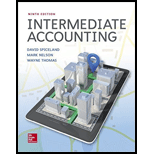
Concept explainers
(1)
Present Value:
The value of today’s amount to be paid or received in the future at a compound interest rate is called as present value. The following formula is used to calculate the present value of an amount:
Future Value: The future value is value of present amount compounded at an interest rate until a particular future date. The future value of an amount is calculated by using the following formula:
The present value of the pension obligation to three employees as of December 31, 2018.
(1)
Present Value:
The value of today’s amount to be paid or received in the future at a compound interest rate is called as present value. The following formula is used to calculate the present value of an amount:
Future Value: The future value is value of present amount compounded at an interest rate until a particular future date. The future value of an amount is calculated by using the following formula:
Explanation of Solution
- For Employee T:
Determine the present value of an ordinary annuity.
PV factor (Present value of an ordinary annuity of $1: n = 15, i = 11%) is taken from the table value (Table 4 in Appendix from textbook).
Determine the present value.
PV factor (Present value of $1: n = 2, i = 10%) is taken from the table value (Table 2 in Appendix from textbook).
- For Employee E:
Determine the present value of an ordinary annuity.
PV factor (Present value of an ordinary annuity of $1: n = 15, i = 11%) is taken from the table value (Table 4 in Appendix from textbook).
Determine the present value.
PV factor (Present value of $1: n = 3, i = 11%) is taken from the table value (Table 2 in Appendix from textbook).
- For Employee C:
Determine the present value of an ordinary annuity.
PV factor (Present value of an ordinary annuity of $1: n = 15, i = 11%) is taken from the table value (Table 4 in Appendix from textbook).
Determine the present value.
PV factor (Present value of $1: n = 4, i = 11%) is taken from the table value (Table 2 in Appendix from textbook).
Thus, following are the present values of the pension obligation of the three employees.
| Employees | Present values ($) |
| T | 116,725 |
| E | 131,447 |
| C | 142,105 |
Table (1)
(2)
To compute: The annual contribution.
(2)
Explanation of Solution
Determine the present value of pension obligation as of December 31, 2021.
| Employee |
PV as of December 31, 2018 | x | FV of $1 factor, | = |
FV as of December 31, 2018 |
| n = 3, i = 11% | |||||
| T | $116,725 | x | 1.36763 | = | $159,637 |
| E | 131,448 | x | 1.36763 | = | 179,772 |
| C | 142,105 | x | 1.36763 | = | 194,347 |
| Total present value, December 31, 2021 | $533,756 | ||||
Table (2)
Compute the annual contribution using future value of annuity due.
FV factor (Future value of an annuity due of $1: n =3, i =11%) is taken from the table value (Table 5 in Appendix from textbook).
Hence, the first contribution that will be made on December 31, 2016 is $143,881.
Want to see more full solutions like this?
Chapter 6 Solutions
GEN COMBO INTERMEDIATE ACCOUNTING; CONNECT ACCESS CARD

 AccountingAccountingISBN:9781337272094Author:WARREN, Carl S., Reeve, James M., Duchac, Jonathan E.Publisher:Cengage Learning,
AccountingAccountingISBN:9781337272094Author:WARREN, Carl S., Reeve, James M., Duchac, Jonathan E.Publisher:Cengage Learning, Accounting Information SystemsAccountingISBN:9781337619202Author:Hall, James A.Publisher:Cengage Learning,
Accounting Information SystemsAccountingISBN:9781337619202Author:Hall, James A.Publisher:Cengage Learning, Horngren's Cost Accounting: A Managerial Emphasis...AccountingISBN:9780134475585Author:Srikant M. Datar, Madhav V. RajanPublisher:PEARSON
Horngren's Cost Accounting: A Managerial Emphasis...AccountingISBN:9780134475585Author:Srikant M. Datar, Madhav V. RajanPublisher:PEARSON Intermediate AccountingAccountingISBN:9781259722660Author:J. David Spiceland, Mark W. Nelson, Wayne M ThomasPublisher:McGraw-Hill Education
Intermediate AccountingAccountingISBN:9781259722660Author:J. David Spiceland, Mark W. Nelson, Wayne M ThomasPublisher:McGraw-Hill Education Financial and Managerial AccountingAccountingISBN:9781259726705Author:John J Wild, Ken W. Shaw, Barbara Chiappetta Fundamental Accounting PrinciplesPublisher:McGraw-Hill Education
Financial and Managerial AccountingAccountingISBN:9781259726705Author:John J Wild, Ken W. Shaw, Barbara Chiappetta Fundamental Accounting PrinciplesPublisher:McGraw-Hill Education





